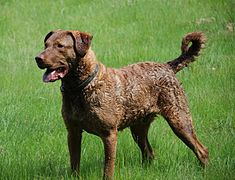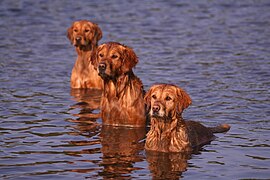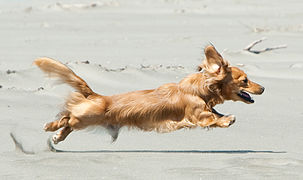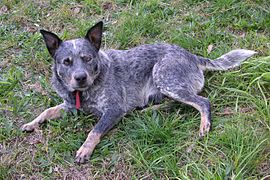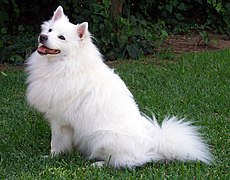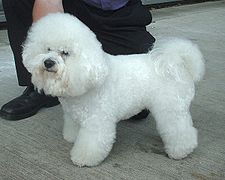Usuario:Jcfidy/Taller
- Capa (perro)

La capa del perro doméstico (Canis lupus familiaris) se refiere al pelo que cubre su cuerpo. La capa de un perro puede ser una capa doble, compuesta de una capa inferior suave y una capa superior más resistente, o una sola capa, que carece de subpelo.[1] Las capas dobles tienen una capa superior, hecha de pelos rígidos para ayudar a repeler el agua y el escudo de la suciedad, y un subpelo que sirve como aislamiento. Los términos pelaje y capa se usan a menudo de forma intercambiable cuando describen el abrigo de perro, sin embargo en general, pelaje, por ejemplo, al igual que el de Terranova y la mayoría de los perros de montaña, se conoce como un abrigo de piel, mientras que una sola capa, al igual que la del caniche, se conoce como un capa.
Colores, patrones, longitudes y texturas[editar]

Hay una mayor variedad de colores de abrigo, patrones, longitudes y texturas que se encuentran en el perro que en relación con el lobo, aunque los perros y los lobos pertenecen a la misma especie (Canis lupus). En diferentes razas se utilizan distintos nombres para los tipos de pelo largo y corto, no hay una nomenclatura estándar para la longitud, los estándares de la raza dan longitudes aceptables por la medición. Los colores de los escudos de los perros no fueron elegidos inicialmente por los humanos, pero probablemente fueron el resultado inadvertido de algún otro proceso de selección (es decir, la selección por la mansedumbre).[2] La investigación ha encontrado que la mansedumbre trae cambios físicos asociados.[3]
Los perros a menudo muestran los restos de contrasombreado, un patrón de camuflaje natural común. El principio básico del contrasombreado es cuando el animal se ilumina desde arriba, las sombras se echarán en el lado ventral del cuerpo. Estas sombras podrían proporcionar un depredador o presa con señales visuales relacionadas con el movimiento del animal. Al ser de color más claro en el lado ventral del cuerpo, un animal puede contrarrestar esto, y por lo tanto engañar al depredador o presa. Una explicación alternativa es que los lados dorsal y ventral de un animal experimentan diferentes presiones de selección (de la necesidad de mezclarse en diferentes fondos cuando se ven desde arriba y abajo) dando lugar a coloración diferente.[4]
Bases genéticas de color y patrón[editar]



Modern breeds of dog exhibit a diverse range of coat colorings, patterns, lengths and textures. In recent years, the understanding of the genetic basis for coat coloring and patterning[5] and coat length and texturing[6] has increased significantly.
There are currently eight known genes within the canine genome that are associated with coat color. Each of these genes occurs in at least two variants, or alleles, which accounts for the variation in coat color between animals. Each of these genes exists at a fixed location, or locus, of the animal's genome. The loci associated with canine coat color are:
- A (agouti) locus
The alleles at the A locus are related to the production of agouti signalling protein (ASIP) and determine whether an animal expresses an agouti appearance, and if so what type, by controlling the distribution of pigment in individual hairs. There are five suspected alleles that occur at the A locus:
- aw = Wild-type agouti (cream to red hair with black tips)
- Ay = Fawn/clear sable (cream to red hair with darker tips) or sable (solid black hairs interspersed amongst lighter reddish hairs)
- at = Tanpoint including saddle tan,[7][8]
- a = Recessive black (inhibition of phaeomelanin)
Most texts suggest that the dominance hierarchy for the A locus alleles appears to be as follows: Ay > aw > at > a, however research suggests the existence of pairwise dominance/recessive relationships in different families and not the existence of a single hierarchy in one family.[9] This means, for example, that Ay may be incompletely dominant over at. Recent studies reveal saddle tan to be a modification of the tanpoint phenotype caused by interaction of other genes with ASIP.
- B (brown) locus
The alleles at the B locus are related to the production of tyrosinase related protein 1 (TYRP1) and determine the degree to which an animal expresses tyrosinase, an enzyme related to the production of melanin, in its coat and skin (including the nose and paw pads). There are two known alleles that can occur at the B locus:
- B = Black
- b = Brown (includes several alleles - bs, bd and bc)
B is dominant to b. An animal that has at least one copy of the B allele will have a black nose, paw pads and eye rims while an animal that is homozygous for any of the b alleles will have a liver nose, paw pads and eye rims.
- D (dilute) locus
The alleles at the D locus (the melanophilin gene or MLPH) are related to the dilution of eumelanin and/or phaeomelanin and determine the intensity of pigmentation. There are two known alleles:
- D = Not Diluted
- d = Diluted (Black becomes grey or blue; brown becomes light tan or "Isabella")
D is dominant to d. Homozygosity of d is sometimes accompanied by hair loss and recurrent skin inflammation, a condition referred to as either color dilution alopecia (CDA) or black hair follicular dysplasia (BHFD) depending upon the breed of dog.[10]
- E (extension) locus
The alleles at the E locus (the melanocortin receptor one gene or MC1R) determines whether an animal expresses a melanistic mask or a grizzle overlay, as well as determining whether an animal expresses eumelanin in its coat. Expression of eumelanin will result in a black or brown coat, while a lack of expression of eumelanin will result in a red or yellow coat. There are four known alleles that occur at the E locus:
- Em = Mask, animal expresses eumelanin (coat will be black or brown)
- EG = Grizzle (dark overlay covering the top and sides of the body, head and tail, and the outside of the limbs)
- E = No mask, animal expresses eumelanin (coat will be black or brown)
- eh = Sable - dirty red, found in English Cocker Spaniels (dark overlay covering the top and sides of the body, head and tail, and the outside of the limbs)
- e = No mask, animal does not express eumelanin (coat will be red or yellow)
The dominance hierarchy for the E locus alleles appears to be as follows: Em > EG > E > eh > e. The Grizzle allele has been studied only in Salukis and Afghan Hounds, the latter in which it is referred to as "Domino". Its placement in the dominance hierarchy has not been solidified. The eh sable extension allele has been studied only in English Cocker Spaniels and produces sable in the presence of all K locus alleles. The expression is dependent upon the animal being homozygous for at and not possessing Em or E. The expression of EG is dependent upon the animal being homozygous for at and not possessing Em or KB.[11] An animal that is homozygous for e will express a red or yellow coat regardless of the alleles at other loci (unless the animal is homozygous for ca at the C locus in which case it will be albino).
- H (harlequin) locus
DNA studies have not yet isolated the gene at the H locus, but the traits associated with it have been mapped to chromosome 9.[12] The H locus is a modifier locus (of the M locus) and the alleles at the H locus will determine if an animal expresses a harlequin pattern (white base with black patches). There are two alleles that can occur at the H locus:
- H = Harlequin
- h = Non-harlequin
H is dominant to h. Breeding data suggests that H is embryonic recessive lethal and that therefore all harlequins are H/h.[12] The Harlequin allele is specific to Great Danes. As H is a modifier locus of the M locus, in order for the Harlequin pattern to be expressed, one copy of the H allele (at the H locus) and one copy of the M allele (at the M locus) must be present (i.e. H/h and M/m).
- K (dominant black) locus
The alleles at the K locus (the β-Defensin 103 gene or DEFB103) determine the coloring pattern of an animal's coat.[13] There are three known alleles that occur at the K locus:
- KB = Solid coloring (does not mean that white markings can not appear)
- kbr = Brindle
- ky = Enables the expression of agouti alleles that require the expression of phaeomelanin
The dominance hierarchy for the K locus alleles appears to be as follows: KB > kbr > ky. The coloring of an animal that possesses at least one KB will be determined by the alleles it possesses at the B and E loci. An animal with one kbr allele and no KB allele will express a brindle pattern to its coat unless it is homozygous for e (at the E locus) or possibly homozygous for a (at the A locus). An animal that is homozygous for ky will express the agouti pattern in accordance with the alleles it has at the A locus.
- M (merle) locus
The alleles at the M locus (the SILV gene) determine whether an animal expresses a merle pattern to its coat (patches of sporadic colored and white hairs and other patches of solid color). There are two alleles that can occur at the M locus:
- M = Merle (visible in dogs that are not e/e)
- m = Non-merle
M is dominant to m. Both heterozygosity and homozygosity of the merle gene (i.e. M/m and M/M) are linked to a range of auditory and ophthalmologic abnormalities.[14]
- S (spotting) locus
The alleles at the S locus (the microphthalmia-associated transcription factor gene or MITF) determine the degree and distribution of spotting of an animal's coat.[15] There is disagreement as to the number of alleles that occur at the S locus, with researchers postulating either two[16] or four[17] alleles. The four alleles postulated are:
- S = Solid color (small areas of white may appear on chest, toes or tail tip)
- si = Irish-spotting (white on muzzle, forehead, feet, legs, chest and tail)
- sp = Pie-bald spotting (large areas of white)
- sw = Extreme pie-bald spotting (Extremely large areas of white, almost completely white)
S is dominant to s. DNA studies have not yet confirmed the existence of all four alleles, with some research suggesting the existence of at least two alleles (S and sp)[15] and other research suggesting the possible existence of a third allele (si).[18] It has been suggested that what appears to be the result of an sw allele is in fact the result of plus and minus modifiers acting on one of the other alleles.[15] It is thought that the spotting that occurs in Dalmatians is the result of the interaction of three loci (the S locus, the T locus and F locus) giving them a unique spotting pattern not found in any other breed.[19]
In 2014, a study found that a simple repeat polymorphism in the MITF-M Promoter is a key regulator of white spotting and that white color had been selected for by humans.[20][21]
Postulated color and pattern loci[editar]
There are at least five additional theoretical loci thought to be associated with coat color in dogs. DNA studies are yet to confirm the existence of these genes or alleles but their existence is theorised based on breeding data:[22]
- C (colored) locus
The alleles at the theoretical C locus are thought to determine the degree to which an animal expresses phaeomelanin, a red-brown protein related to the production of melanin, in its coat and skin. Five alleles are theorised to occur at the C locus:
- C = Full color (animal expresses phaeomelanin)
- cch = Chinchilla (partial inhibition of phaeomelanin resulting in decreased red pigment)
- ce = Extreme dilution (inhibition of phaeomelanin resulting in extremely reduced red pigment)
- cb/cp = Blue-eyed albino/Platinum (almost total inhibition of phaeomelanin resulting in near albino appearance)
- ca = Albino (complete inhibition of phaeomelanin production, resulting in complete inhibition of melanin production)
The C locus in dogs is not well understood and the theorised alleles are based on those present in other species.[17] True albinism has not been conclusively shown to exist in dogs. It is thought that an animal that is heterozygous for the C allele with one of the other alleles will express a result somewhere between the two alleles.[23]
- F (flecking) locus
The alleles at the theoretical F locus are thought to determine whether an animal displays small, isolated regions of white in otherwise pigmented regions (not apparent on white animals). Two alleles are theorised to occur at the F locus:
- F = Flecked
- f = Not flecked
It is thought that F is dominant to f.[19]
- G (progressive greying) locus
The alleles at the theoretical G locus are thought to determine if premature greying of the animal's coat will occur. Two alleles are theorised to occur at the G locus:
- G = Premature greying
- g = No premature greying
It is thought that G is dominant to g.
- I (intensity) locus
The alleles at the theoretical I locus are thought to affect phaeomelanin expression. Two alleles are theorised to occur at the I locus:
- I = Intense red, not diluted
- i = Not intense red
It is thought that I and i are co-dominant, so that animals with i/i will be paler than animals with I/i.
- T (ticking) locus
The alleles at the theoretical T locus are thought to determine whether an animal displays small, isolated regions of pigment in otherwise white regions (not apparent on non-white animals). Two alleles are theorised to occur at the T locus:
- T = Ticked
- t = Not ticked
It is thought that T is dominant to t.
Genetic basis of length and texture[editar]
Research indicates that the majority of variation in coat growth pattern, length and curl can be attributed to mutations in three genes, the R-spondin-2 gene or RSPO2, the fibroblast growth factor-5 gene or FGF5, and the keratin-71 gene or KRT71.[6]
- The L (length) locus
The alleles at the L locus (the fibroblast growth factor-5 gene or FGF5) determine the length of the animal's coat.[24] There are two known alleles that occur at the L locus:
- L = Short coat
- l = Long coat
L is dominant to l. A long coat is demonstrated when a dog has pair of recessive 'l' alleles at this locus.
- The W (wired) locus

The alleles at the W locus (the R-spondin-2 gene or RSPO2) determine the coarseness and the presence of "facial furnishings" (e.g. beard, moustache, eyebrows).[6] There are two known alleles that occur at the W locus:
- W = Wire (hair is coarse and facial furnishings present)
- w = Non-wire (hair is not coarse and facial furnishings are not present)
W is dominant to w. Animals that are homozygous for l (i.e. l/l) and possess at least one copy of W will have long, soft coats with furnishings, rather than wirey coats.[6]
- The R (curl) Locus[note 1]

The alleles at the R locus (the keratin-71 gene or KRT71) determine whether an animal's coat is straight or curly.[6] There are two known alleles that occur at the R locus:
- R = Straight
- r = Curly
R is dominant to r.
- Interaction of Length & Texture Genes
These three genes responsible for the length and texture of an animal's coat interact to produce eight different phenotypes:[6]
- Hairless (e.g. Chihuahua)
- Short (e.g. Basset Hound)
- Wire (e.g. Australian Terrier)
- Curly-wire (e.g. Airedale Terrier)
- Long (e.g. Golden Retriever)
- Long with furnishings (e.g. Bearded Collie)
- Long and curly (e.g. Irish Water Spaniel)
- Long and curly with furnishings (e.g. Bichon Frisé)
Hair growth[editar]


The coat of most dogs grows to a specific length and then stops growing, while the coats of some dogs grow continuously in a manner similar to human hair growth. A long-coated dog with a single dominant furnishings allele (wire coat), will demonstrate this feature. Examples of breeds of dog whose coats grow continuously are:
- Australian Silky Terrier
- Bedlington Terrier
- Bichon Frisé
- Maltese
- Poodle
- Skye Terrier
- Soft Coated Wheaten Terrier
- Yorkshire Terrier
- Shih Tzu
- Lhasa Apso
- Coton de tulear
- Tibetan terrier
- Corded Coats
Corded coats, like those of the Puli and Komondor are thought to be the result of continuously growing curly coats. Other breeds with continuously growing curly coats, such as the Poodle, can also be groomed to cord.
- Hairless
Some breeds of dog do not grow hair on parts of their bodies and may be referred to as "hairless". Examples of "hairless" dogs are the Xoloitzcuintli (Mexican Hairless Dog), the Peruvian Inca Orchid (Peruvian Hairless Dog) and the Chinese Crested. Research suggests that hairlessness is caused by a dominant allele, which is homozygous lethal.[25]
Genetic testing and phenotype prediction[editar]
In recent years genetic testing for the alleles of some genes has become available[26] Software is also available to assist breeders in determining the likely outcome of matings.[27]
Nomenclature of colors and patterns[editar]
Colors[editar]
The same color may be referred to differently in different breeds. Likewise, a same term may mean different colourations in different breeds.
- Brown, chocolate, liver
Brown, chocolate and liver are the most common terms used to refer to the bb-dilution of black pigment to a dark brown. Depending on breed and exact shade, terms such as mahogany, midtone brown, grey-brown, blackish brown are used. Sedge and deadgrass are used to describe the desired Chesapeake Bay Retriever color that resembles "that of its working surroundings" as closely as possible.
-
Brown Chesapeake Bay Retriever
-
Dark and light chocolate Labrador Retrievers
- Red
Red refers to reddish shades of orange, brown, and tan. Terms used include orange, red-gold, cinnamon, tan, and ruby. Genetically a dog called red is usually a clear sable (with little to no eumelanin tipping on hairs) or a ruddy recessive yellow.
In some breeds, "red" refers to what would usually be called brown, chocolate, or liver. A "red merle" is always a liver-based merle. In Australian Cattle Dogs, blue stands for a densely ticked liver-based colouration with an overall red-grey appearance.
-
Red Irish Setter
-
Red Chow Chow
-
Red Standard Poodle
-
Red Australian Cattle Dog
- Gold and yellow
Gold refers specifically to a rich reddish-yellow and its variants, whereas yellow can refer to any shade of yellow and tan. Terms used include yellow-gold, lion-colored, fawn, apricot, wheaten, tawny, straw, yellow-red, mustard, sandy, honey, apricot, blond, lemon. Dogs called golden or yellow tend to be recessive yellow, but can also be sable.
-
Apricot Poodle
-
Dark Golden Retrievers
-
Yellow Dachshund
-
Yellow Labrador Retriever
- Cream
Cream refers to a pale yellowish or tannish colour which can be almost white.
-
Pale cream Standard Poodle
-
Cream French Bulldog
-
Cream Akita
- Fawn
Fawn typically refers to a yellow, tan, light brown, or cream dog that has a dark melanistic mask.
With Weimaraners, fawn refers to their typical brownish grey colouration that with other breeds is usually called lilac.
-
Fawn Pug
-
Fawn English Mastiff
-
Fawn Boxer
- Black
Black is a pure black that can get grizzled as the dog ages, or have a tendency to gain a brownish cast when exposed to the elements.
-
Black Labrador Retriever
- Blue
Blue is a cool-toned, metallic grey. It typically means a dd-dilution of black pigment, a grey colouration that is grey from birth, but has a wide range of breed-specific meanings.
In Kerry Blue Terriers, Poodles, and Bearded Collies, "blue" refers to colouration that is black at birth and progressively greys out as the dog matures. In Australian Shepherds, Rough Collies, and Shetland Sheepdogs, blue means a blue (black-based) merle. In Australian Silky Terriers, blue means a saddle-type black and tan pattern, where the black parts of the coat progressively fade to a steel grey as the dog matures, and in Australian Cattle Dogs, blue stands for a densely ticked black-based colouration with an overall blue-grey appearance.
-
Blue Neapolitan Mastiff
-
Blue mixed-breed dog
-
Blue Australian Cattle Dog
- Grey
Grey simply means a grey colouration of any shade. It can be used as an alternative synonym of blue, but tends to mean some other type of grey than the dd-dilution of black ("true" blue). Synonyms include silver, pepper, grizzle, slate, blue-black grey, black and silver, steel. Greys of a dusty or brownish cast are often lilac, a dd-dilution of liver, and this colouration does not have much of a commonly recognised name. Across various breeds, it is called lavender, silver-fawn, isabella, fawn, café au lait or silver beige.
In Poodles, a blue is a very slowly fading, very dark steel grey, whereas a silver is a quicker to clear, much lighter grey that can range from a pale platinum to a steel grey. Both are black at birth with minimal markings to indicate future change. Similarly, café au lait is a slower and darker and silver beige a quicker and lighter progressively greying brown, i.e. liver.
-
Lighter and darker fawn Weimaraners
-
Silver Miniature Schnauzer
-
Silver Miniature Poodle
-
Isabella/fawn Dobermann
- White
White: Such a light cream that it is seen and described as pure white, making them distinct from albino dogs. A white dog, as opposed to an albino one, has dark pigment around the eye rims and nose, often coupled with dark-colored eyes. There is often some coat identifiable as cream between the dog's shoulder blades.
-
White American Eskimo Dog
-
White Bichon Frisé
Patterns[editar]
The same pattern may be referred to differently in different breeds.
 Liver and tan Australian Kelpie |
 Black and tan Rottweiler |
Black and tan, liver and tan, blue and tan: Coat has both colors but in clearly defined and separated areas, usually with the darker color on most of the body and tan (reddish variants) underneath and in highlights such as the eyebrows. Black and brindle and liver and brindle, in which the same pattern is evident with brindling in place of tan, are also possible, but less common. |
 Black and white Border Collie |
 Blenheim (Red-brown and white) Cavalier King Charles Spaniel |
Bicolor (also called Two-color, Irish spotted, Flashy, Patched, Tuxedo) Any color or pattern coupled with white spotting. This can range anywhere from white toes and tail tip to a mostly-white dog with color around the base of the ears and tail. Some breeds have special names for the color combinations; for example, Cavalier King Charles Spaniel uses Blenheim for reddish brown (chestnut) and white. Irish Spotted or flashy pattern is symmetrical and includes a white chest, white band around the neck, white belly, and white feet or "boots." This pattern is commonly seen in herding dogs, and Boxers, among others. The piebald gene is responsible for this pattern. |
 Black tricolor Entlebucher Mountain Dog |
 Tricolor Beagle |
Tricolor: Three clearly defined colors, usually either black, liver, or blue on the dog's upper parts, white underneath, with a tan border between and tan highlights; for example, the Smooth Collie, the Rough Collie, the Papillon,or the Sheltie. Tricolor can also refer to a dog whose coat is patched, usually two colors (such as black and tan) on a white background. |
 Blue merle tricolor Shetland Sheepdog |
 Red merle Catahoula Leopard Dogs |
Merle: Marbled coat with darker patches and spots of the specified color. Merle is referred to as "Dapple" with Dachshunds. |
| Archivo:Tuxedomix.jpg Tuxedo Lab mix. |
Archivo:Red tuxedo2.jpg Tuxedo Collie mix |
Tuxedo: Solid (often black) with a white patch (shirt front) on the chest and chin, and white on some or all of the feet (spats.) The tuxedo pattern is common in dogs that carry only one piebald gene (a heterozygous carrier). |
 Harlequin Great Dane |
 Harlequin Great Dane |
Harlequin: "ripped" splotches of black on white. The Great Dane is the only breed with this pattern. Sometimes, like with the parti-colored poodle Poodle, the term 'harlequin is incorrectly used to describe the coat pattern, but the gene responsible for the patches of color in some poodles is piebald, which is present in many dog breeds and most of the ones which some white on their coats. |
 Spotted Dalmatian |
 Spotted mutt in Sinamaica, Venezuela |
Spotted Coin-sized pigmented spots on a white background. The spotting on Dalmatians is unique as it involves mutations in at least three different spotting genes.[19] |
 Red-speckled Australian Cattle Dog |
 Liver-ticked German Shorthaired Pointer |
Flecked, ticked, speckled: also called belton in English Setters |
 Orange belton (orange and white speckled) English Setter |
 Blue speckled Australian Cattle Dog | |
 Densely brindled liver and white Boston Terrier |
 Very sparsely brindled Great Dane |
Brindle: A mixture of black/liver/blue/lilac and red/yellow/cream arranged in a vertical "tiger stripe" pattern. |
| Archivo:Rambo the Airedale Terrier.jpg Airedale Terrier with large black saddle |
 Norwegian Dunker with merle-affected black saddle |
Saddle or blanket: A different color, usually darker, over the centre of the back. |
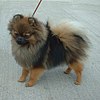 Dark orange sable Pomeranian |
 Clear sable Australian Terrier |
Sable: Black-tipped hairs; the rest of the hair can be gold to yellow, silver, grey, or tan. The darkness of the coat depends on how much of each hair is black versus the lighter color. Totally clear sables might only have black in their whiskers. |
Show coats[editar]
The nature and quality of a purebred dog's coat is important to the dog fancy in the judging of the dog at conformation shows. The exact requirements are detailed in each breed's breed standard and do not generalise in any way, and the terminology may be very different even when referring to similar features. See individual breed articles for specific information.
Shedding[editar]

Every hair in the dog coat grows from a hair follicle, which has a three phase cycle, as do most mammals. These cycles are: anagen, growth of normal hair; catagen growth slows, and hair shaft thins; telogen, hair growth stops, the follicle rests, and the old hair falls off—is shed. At the end of the telogen phase, the follicle begins the cycle again.[28]
Hypoallergenic coats[editar]

Some dog breeds have been promoted as hypoallergenic (which means less allergic, not free of allergens) because they shed very little. However, no canine is known to be completely nonallergenic. Often the problem is with the dog's saliva or dander, not the fur.[29] Although poodles, bichons, yorkies, and terriers are commonly represented as being hypoallergenic, the reaction that an individual person has to an individual dog may vary greatly. In treating dog related allergies, it has been found that "Factors related to individual dogs seem to influence the allergenicity more than breed..."[30]
See also[editar]
- Cat coat genetics
- Dog grooming
- Equine coat color genetics
- Farm-Fox Experiment
- Hypoallergenic
- List of dog breeds
- Merle (coat color in dogs)
- Dog skin disorders
Notes[editar]
- ↑ Researchers have not yet assigned a letter to this locus and "R" has been selected based on the use of the term "Rex" for curled hair in domestic cats.
Referencias[editar]
- ↑ «How to Keep Your Dog Warm This Winter». Spoiled Pets Shop. 2014. Consultado el November 10, 2014.
- ↑ James Serpell, ed. (1995). The Domestic Dog: Its Evolution, Behaviour and Interactions with People. Cambridge, United Kingdom: Cambridge University Press. p. 284. ISBN 0-521-42537-9.
- ↑ Lyudmila N. Trut (March–April 1999). «Early Canid Domestication: The Farm-Fox Experiment». American Scientist 87 (2): 160-169. doi:10.1511/1999.2.160.
- ↑ Graeme D. Ruxton; Michael P. Speed; David J. Kelly (September 2004). «What, if anything, is the adaptive function of countershading?». Animal Behaviour 68 (3): 445-451. doi:10.1016/j.anbehav.2003.12.009.
- ↑ Schmutz, S. M.; Berryere, T. G. (December 2007). «Genes affecting coat color and pattern in domestic dogs: a review». Animal Genetics 38 (6): 539-549. PMID 18052939. doi:10.1111/j.1365-2052.2007.01664.x.
- ↑ a b c d e f Edouard Cadieu; Mark W. Neff; Pascale Quignon; Kari Walsh; Kevin Chase; Heidi G. Parker; Bridgett M. VonHoldt; Alison Rhue; Adam Boyko; Alexandra Byers; Aaron Wong; Dana S. Mosher; Abdel G. Elkahloun; Tyrone C. Spady; Catherine André; K. Gordon Lark; Michelle Cargill; Carlos D. Bustamante; Robert K. Wayne; Elaine A. Ostrander (October 2009). «Coat Variation in the Domestic Dog Is Governed by Variants in Three Genes». Science 326 (5949): 150-153. PMC 2897713. PMID 19713490. doi:10.1126/science.1177808.
- ↑ Dreger, Dayna L.; Schmutz, Sheila M. (2011). «A SINE Insertion Causes the Black-and-Tan and Saddle Tan Phenotypes in Domestic Dogs». Journal of Heredity 102: S11-S18. PMID 21846741. doi:10.1093/jhered/esr042.
- ↑ Dreger DL, Parker H, Ostrander E, Schmutz SM. The involvement of RALY in a complex gene interaction producing the saddle tan phenotype in dogs. A presentation at Advances in Canine and Feline Genomics and Inherited Diseases 2012 Conference, Visby, Sweden. June 1, 2012.
- ↑ Julie A. Kerns; J. Newton; Tom G. Berryere; Edward M. Rubin; Jan-Fang Cheng; Sheila M. Schmutz; Gregory S. Barsh (October 2004). «Characterization of the dog Agouti gene and a nonagouti mutation in German Shepherd Dogs». Mammalian Genome 15 (10): 798-808. ISSN 0938-8990. PMID 15520882. doi:10.1007/s00335-004-2377-1.
- ↑ Ute Philipp; Henning Hamann; Lars Mecklenburg; Seiji Nishino; Emmanuel Mignot; Anne-Rose Günzel-Apel; Sheila M Schmutz; Tosso Leeb (June 2005). «Polymorphisms within the canine MLPH gene are associated with dilute coat color in dogs». BMC Genetics 6 (34): 34. ISSN 1471-2156. PMC 1183202. PMID 15960853. doi:10.1186/1471-2156-6-34.
- ↑ Dayna L. Dreger; Sheila M. Schmutz (Jun 2010). «A New Mutation in MC1R Explains a Coat Color Phenotype in 2 ‘‘Old’’ Breeds: Saluki and Afghan Hound». Journal of Heredity 101 (5): 644-649. PMID 20525767. doi:10.1093/jhered/esq061.
- ↑ a b Leigh Anne Clark; Alison N. Starr; Kate L. Tsai; Keith E. Murphy (July 2008). «Genome-wide linkage scan localizes the harlequin locus in the Great Dane to chromosome 9». Gene 418 (1–2): 49-52. PMID 18513894. doi:10.1016/j.gene.2008.04.006.
- ↑ Sophie I. Candille; Christopher B. Kaelin; Bruce M. Cattanach; Bin Yu; Darren A. Thompson; Matthew A. Nix; Julie A. Kerns; Sheila M. Schmutz; Glenn L. Millhauser; Gregory S. Barsh (November 2007). «A β-Defensin Mutation Causes Black Coat Color in Domestic Dogs». Science 318 (5855): 1418-1423. PMC 2906624. PMID 17947548. doi:10.1126/science.1147880.
- ↑ Leigh Anne Clark; Jacquelyn M. Wahl; Christine A. Rees; Keith E. Murphy (January 2006). «Retrotransposon insertion in SILV is responsible for merle patterning of the domestic dog». PNAS 103 (5): 1376-1381. ISSN 0273-1134. PMC 1360527. PMID 16407134. doi:10.1073/pnas.0506940103.
- ↑ a b c Sheila M. Schmutz; Tom G. Berryere; Dayna L. Dreger (June 2009). «MITF and White Spotting in Dogs: A Population Study». Journal of Heredity 100 (Supplement 1): 566-574. doi:10.1093/jhered/esp029.
- ↑ Winge, Ojvind (1950). Inheritance in Dogs: With Special Reference to the Hunting Breeds. Catherine Roberts (translator). Ithaca, N.Y.: Comstock Publishing. p. 194.
- ↑ a b Little, Clarence Cook (1957). The Inheritance of Coat Color in Dogs. New York: Comstock Publishing. p. 194. ISBN 0-87605-621-4.
- ↑ Karlsson E. K.; Baranowska I.; Wade C. M.; Salmon Hillbertz N. H.; Zody M. C.; Anderson N.; Biagi T. M.; Patterson N.; Pielberg G. R.; Kulbokas E. J. III; Comstock K. E.; Keller E. T.; Mesirov J. P.; von Euler H.; Kämpe O.; Hedhammar A.; Lander E. S.; Andersson G.; Andersson L.; Lindblad-Toh K. (November 2007). «Efficient mapping of mendelian traits in dogs through genome-wide association». Nature Genetics 39 (11): 1304-1306. PMID 17906626. doi:10.1038/ng.2007.10.
- ↑ a b c Edward J. Cargill1, Thomas R. Famula, Robert D. Schnabel, George M. Strain & Keith E. Murphy (July 2005). «The color of a Dalmatian's spots: Linkage evidence to support the TYRP1 gene». BMC Veterinary Research 1 (1): 1. ISBN 1-74661-481-1. PMC 1192828. PMID 16045797. doi:10.1186/1746-6148-1-1.
- ↑ Why white dogs are white Uppsala University 2014
- ↑ Baranowska Körberg, Izabella; Sundström, Elisabeth; Meadows, Jennifer R. S.; Rosengren Pielberg, Gerli; Gustafson, Ulla; Hedhammar, Åke; Karlsson, Elinor K.; Seddon, Jennifer; Söderberg, Arne; Vilà, Carles; Zhang, Xiaolan; Åkesson, Mikael; Lindblad-Toh, Kerstin; Andersson, Göran; Andersson, Leif (2014). «A Simple Repeat Polymorphism in the MITF-M Promoter is a Key Regulator of White Spotting in Dogs». PLoS ONE 9 (8): e104363. PMC 4130573. PMID 25116146. doi:10.1371/journal.pone.0104363.
- ↑ Sheila M. Schmutz (December 27, 2008). «Coat Color Alleles in Dogs». Consultado el September 12, 2010.
- ↑ Pamela A. Davol (January 29, 2001). «B/b, E/e, and Beyond: A Detailed Examination of Coat Color Genetics in the Labrador Retriever». Consultado el September 11, 2010.
- ↑ D. J. E. Housley; P. J. Venta (August 2006). «The long and the short of it: evidence that FGF5 is a major determinant of canine ‘hair’-itability». Animal Genetics 37 (4): 309-315. PMID 16879338. doi:10.1111/j.1365-2052.2006.01448.x.
- ↑ Droegemueller, C; Karlsson, EK; Hytšnen, MK; Perloski, M; Dolf, G; Sainio, K; Lohi, H; Lindblad-Toh, K et al. (2008). «A mutation in hairless dogs implicates FOXI3 in ectodermal development». Science 321: 1462.
- ↑ «Vet Gen». Veterinary Genetic Services. 2010. Consultado el September 12, 2010.
- ↑ «Breeders Assistant». Premier Pedigree Software. 2009. Consultado el September 12, 2010.
- ↑ Evans, Howard E.; de Lahunta, Alexander (August 7, 2013). Miller's Anatomy of the Dog (Fourth edición). Saunders. pp. 71-73. ISBN 978-1437708127.
- ↑ Grady, Denise (February 5, 1997). «Nonallergenic Dog? Not Really». New York Times. Consultado el April 3, 2011.
- ↑ «Environmental Exposure to Allergens of Different Dog Breeds and Relevance in Allergological Diagnostics». Journal of Toxicology and Environmental Health, Part A 71 (11–12): 751-8. Jan 2008. PMID 18569573. doi:10.1080/15287390801985513. Parámetro desconocido
|vauthors=ignorado (ayuda)
Additional reading[editar]
- Cunliffe, Juliette (2004). «Coat Types, Colors and Markings». The Encyclopedia of Dog Breeds. Paragon Publishing. pp. 20-23 and various. ISBN 0-7525-8276-3.
- Fogle, Bruce (2000). «The Breed Section Explained». The New Encyclopedia of the Dog. Dorling Kindersley. p. 83 and various. ISBN 0-7513-0471-9.
External links[editar]
- Schmutz, Sheila M. (March 4, 2010). «Dog Coat Color Genetics». University of Saskatchewan. Consultado el September 12, 2010.

